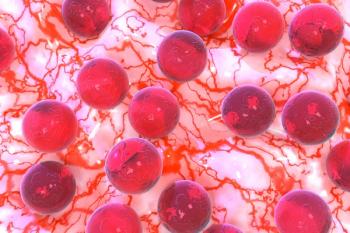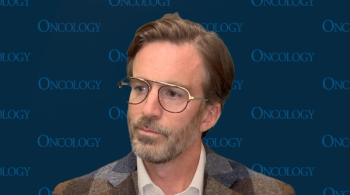
- Oncology Vol 29 No 4_Suppl_1
- Volume 29
- Issue 4_Suppl_1
(S040) Has Severe Acute Esophagitis Been Reduced by 21st Century Treatment Modalities Among Patients With Limited-Stage Small-Cell Lung Cancer?
Patients with tumors ≥ 5 cm, receiving immediate CChRT or twice-daily RT, and having local-regional failure experienced significantly higher rates of severe acute esophagitis. IMRT did not reduce acute severe esophagitis.
Ritsuko Komaki, MD, Pamela K. Allen, PhD, Xiong Wei, Emma B. Holliday, MD, Brett Carter, MD, Stephen D. Bilton, CMD, James D. Cox, MD; UT MD Anderson Cancer Center
PURPOSE: Severe acute esophagitis (grade 3–5) is a limiting factor when twice-daily radiation treatment (RT) with concurrent chemotherapy (CChRT) is applied. The previous Intergroup study (IG 0096) has shown a significant 27 % rate of severe acute esophagitis with twice-daily RT compared to an 11 % esophagitis rate with daily RT and concurrent etoposide and cisplatin (EP) among patients with limited-stage small-cell lung cancer (SCLC) (P < .01), although twice-daily treatment significantly improved 5-year overall survival (OS). Neither intensity-modulated radiation therapy (IMRT) nor three-dimensional conformal radiotherapy (3D-CRT) was used for the IG 0069 study. We investigated if IMRT has reduced severe acute esophagitis with concurrent EP in our institution.
METHODS: We identified 577 patients with limited-stage SCLC treated at a single institution from 1986–2009 with definitive CChRT to a total dose of at least 45 Gy. Candidate variables included tumor size, year of diagnosis, gender, age, Karnofsky performance status (KPS), ethnicity, radiation dose, cycles of induction chemotherapy, use of IMRT, and once- vs twice-daily fractionation. Tumor measurement used the biggest dimension of the primary or regional node. The chi-square test was used for between-group comparisons for categorical variables, and the median test was used for between-group comparisons for continuous variables. Kaplan-Meier estimates were constructed for OS, disease-free survival (DFS), local recurrence–free survival (LRFS), and distant metastasis–free survival (DMFS). Analysis was performed using logistic regression analysis with severe acute esophagitis as the primary endpoint.
RESULTS: Of the 577 patients included in this analysis, 520 patients had tumor size data available. Patients with severe esophagitis were treated with immediate CChRT (n = 99 [95%] vs n = 5 [5%]; P < .001), more likely to have a KPS score < 90 (n = 50 [48%] vs n = 45 [43%]; P = .008), treated with radiation therapy twice daily (n = 66 [63%] vs n = 34 [33%]; P = .01), had been treated since 2000 (n = 47 [55%] vs n = 47 [45%]; P = .02), and had tumors ≥ 5 cm (n = 66 [63%] vs n = 34 [33%]; P = .01) All other patient, tumor, and treatment characteristics were not significantly different between the groups. For the entire cohort, Kaplan-Meier estimates showed severe esophagitis to be associated with reduced local-regional failure–free survival (5-year survival 39.3% vs 53.2%; P = .027). Logistic regression analysis found immediate CChRT (odds ratio [OR] = 2.39; P = .001) and tumor size ≥ 5 cm (OR = 1.66; P = .024) to be associated with severe esophagitis.
CONCLUSIONS: Patients with tumors ≥ 5 cm, receiving immediate CChRT or twice-daily RT, and having local-regional failure experienced significantly higher rates of severe acute esophagitis. IMRT did not reduce acute severe esophagitis.
Proceedings of the 97th Annual Meeting of the American Radium Society -
Articles in this issue
Newsletter
Stay up to date on recent advances in the multidisciplinary approach to cancer.


















































































